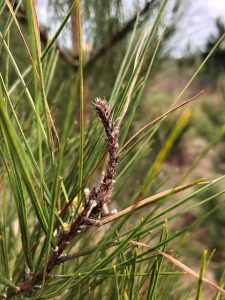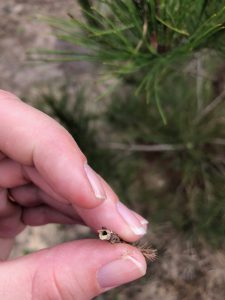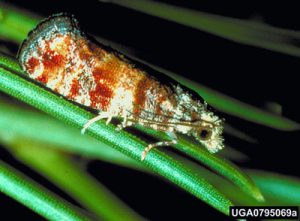Ah, the oft-ignored pine tree. They are so ubiquitous throughout the southeast, that many people consider them undesirable in a landscape. Having grown up near the “Pine Belt” of Mississippi, I figured I knew plenty about them, but this week I learned something new. While on a field tour with local foresters in the business of loblolly and longleaf pine farming, they introduced me to the pine tip moth. These insects can wreak havoc on valuable young pine trees.

Dead branch tip and needle damage caused by pine tip moths. Photo credit: Carrie Stevenson, UF IFAS Extension

Hollow space in pine tree branch created by pine tip moth. Photo credit: Carrie Stevenson, UF IFAS Extension
Female pine tip moths lay eggs on the growing end of a pine branch—particularly young, healthy loblolly and shortleaf (longleaf is rarely affected). When the eggs hatch 5-30 days later, the larvae start feeding. They tunnel into the shoot and bud of the pines, feeding on the tissue and burrowing a hollow cavity for several weeks. The larvae then pupate inside the space until becoming adult moths, exiting from the hole they created. The cycle restarts, with more adult moths, eggs and larvae.

Adult Nantucket pine tip moth Rhyacionia frustrana (Comstock). Photograph by James A. Richmond, USDA Forest Service, www.Forestryimages.org.
Two insect species are most common in our area; the subtropical pine tip moth (Rhyacionia subtropica) and Nantucket pine tip moth (Rhyacionia frustrana). The moths are reddish copper in color, small (1/2” wingspan and 1/4” body length) and active at night. Caterpillar larvae have black heads and start out with off-white bodies, but change in color to brown and orange as they age.
While this insect activity typically does not kill the tree, it does cause some die-off of terminal needles and branches. In extreme cases, it can cause tree death. Moths prefer younger trees and rarely affect pines taller than 15 feet.
If you see a cluster of dead needles at the ends of young pine branches of your property, you can easily snap off the dead tip. You will likely find the hollow space formed by the larvae, which in spring may still contain the insect. Treatment in a home landscape can managed by hand removal of infested shoots, but those in the commercial forestry business may need to install traps and consider insecticidal management.
Visit the UF School of Forest Resources and Conservation website for more information.
- Crane Flies - April 18, 2024
- Rosemary - March 7, 2024
- The Franklin Tree - January 18, 2024
